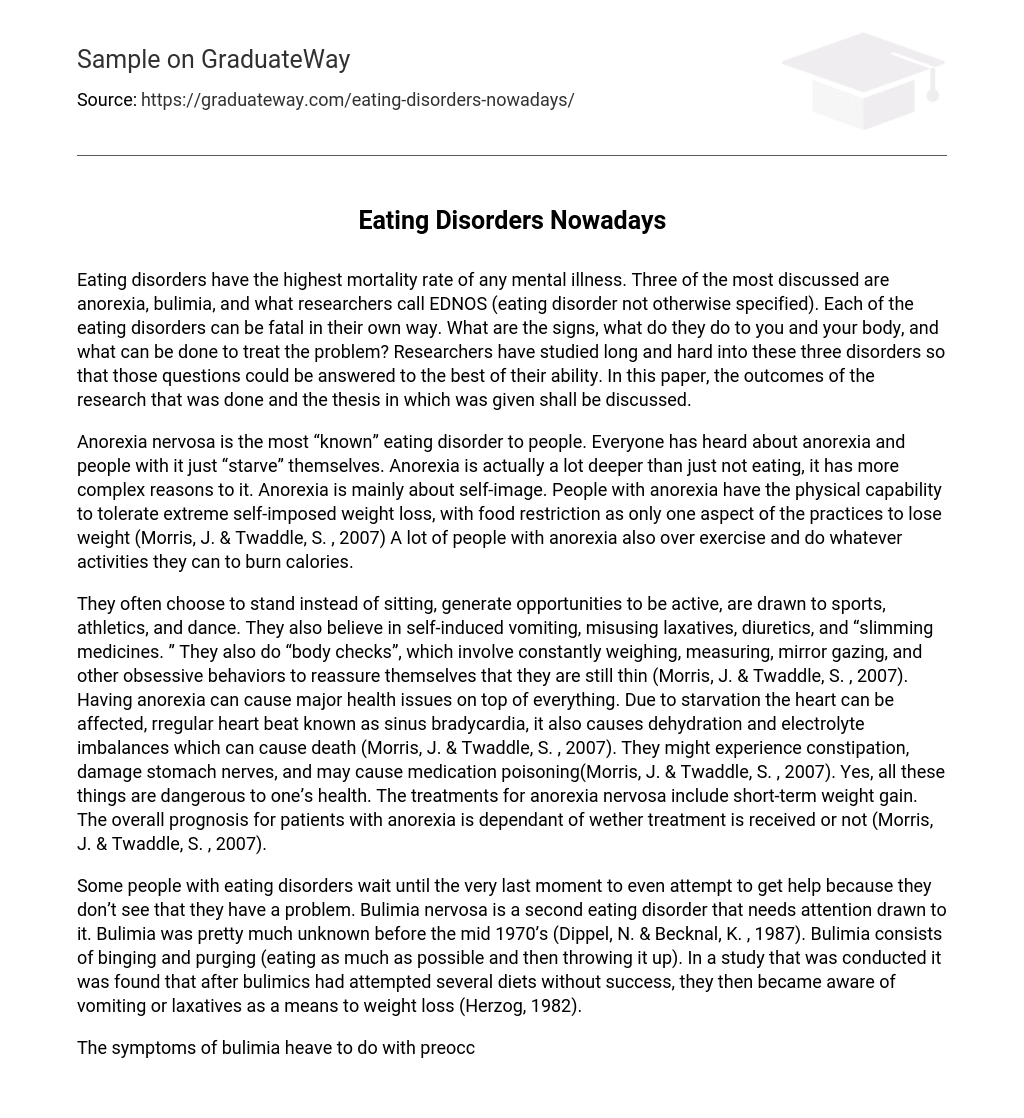The mortality rate of eating disorders, including anorexia, bulimia, and EDNOS (eating disorder not otherwise specified), is the highest among all mental illnesses. Each disorder within this category has its own unique way of causing fatality. Researchers have extensively studied the signs, effects on the body, and potential treatments for these disorders. This paper will delve into the research outcomes and thesis presented regarding this topic.
Anorexia nervosa is a famous eating disorder that involves self-imposed starvation. However, anorexia is not simply a refusal to eat; it has complex underlying causes. The main factor in anorexia is distorted self-image. People with this condition have the physical ability to undergo drastic weight loss through different methods, such as food restriction (Morris, J. & Twaddle, S., 2007). Moreover, many individuals with anorexia also partake in excessive exercise and pursue activities that help them burn calories.
Individuals with anorexia often choose to stand instead of sitting, actively seeking opportunities to engage in sports, athletics, and dance. They also engage in harmful behaviors such as self-induced vomiting, misuse of laxatives, diuretics, and “slimming medicines.” Another detrimental behavior they exhibit is “body checks,” which involve constant weighing, measuring, mirror gazing, and other obsessive actions to confirm their thinness (Morris & Twaddle, 2007).
Anorexia can lead to severe health problems. Starvation can negatively affect the heart, causing an irregular heartbeat known as sinus bradycardia. It also results in dehydration and electrolyte imbalances that can be fatal (Morris & Twaddle, 2007). Additionally, individuals with anorexia may experience constipation,
damage to stomach nerves,
and even medication poisoning (Morris & Twaddle,
2007).
These health complications pose significant dangers.
The treatment for anorexia nervosa involves short-term weight gain.
The overall prognosis for individuals with anorexia depends on whether they receive proper treatment or not (Morris & Twaddle,
2007).
Often, individuals with eating disorders delay seeking help because they fail to recognize their own issues. Bulimia nervosa is an eating disorder that requires attention and was relatively unknown before the mid-1970s (Dippel, N. & Becknal, K., 1987). It involves excessive eating followed by purging through vomiting. A study conducted by Herzog in 1982 found that individuals with bulimia became aware of using vomiting or laxatives as a method of weight loss after trying various unsuccessful diets.
The symptoms of bulimia, as noted by Dippel, N. & Becknal, K. (1987), revolve around preoccupations with food, weight, body image, and the act of purging consumed meals. Feelings of guilt arising from indulging in forbidden foods often lead to induced vomiting. Purging not only serves the purpose of eliminating ingested food but also functions as a means to dispose of unwanted emotions. Typically, individuals begin engaging in purging behaviors approximately one year after they start binge eating. While these facts are concerning on their own accord, the repercussions of bulimia on an individual’s overall well-being are even more distressing.
Subtle changes such as dental erosion from gastric acid and parotid swelling were noted (Levin, 1980). Chronic exposure to gastric acid (vomiting) can lead to extensive decay. Additionally, stomach ulcers, involuntary vomiting, sore throats, and rectal bleeding may occur (Brockopp, 1984: Herzog, 1982). Electrolyte loss due to frequent vomiting can cause dehydration and low potassium levels in bulimics, potentially leading to cardiac arrest. Cardiac arrest is the primary cause of death among individuals with bulimia (Evans, 1968).
The best known treatment for bulimia at the time may involve elements from family therapy, behavior therapy, psychotherapy, drug therapy, and support groups (Pope, 1984). EDNOS (eating disorders not otherwise specified) is another eating disorder that requires attention. While different from anorexia and bulimia, it does have some similar identifying factors. In EDNOS, a patient’s presentation doesn’t meet the criteria for anorexia or bulimia but does consist of disordered eating patterns and experiences of distress or impairment in daily life (APA, 2000; Schwitzer et al., 1998). Individuals with EDNOS often have behavioral issues or problems. Symptoms of EDNOS include mood and anxiety problems, moderate depression, periods of suicidal idealation, and body-related issues (Schwitzer et al., 1998). Women with this disorder frequently experience a combination of low self-esteem and perfectionism (Peck & Lightsey, 2008; Schwitzer et al., 1998). These women are often considered “mentally fragile.” Behavior is the primary concern with EDNOS.
People with this disorder (usually women) often face internal struggles within their families and are highly dependent (Schwitzer et al., 1998). While EDNOS primarily affects mental health rather than physical health, the risk of suicide is a significant concern. Excessive anxiety and stress can also impact the body and overall well-being. Treatment options for EDNOS include preventive intervention, intermediate intervention, and psychotherapeutic intervention (Schwitzer et al., 1998). All of these treatments involve counseling but employ different approaches. The ultimate goal of these three methods is to reduce the prevalence of EDNOS in the future. Eating disorders continue to afflict our world daily, which piqued my interest as a full-time student seeking to understand the intricacies of different eating disorders. Through my research, I found detailed answers to my questions.
Researchers were drawn to studying eating disorders because of their growing prevalence and detrimental effects on young individuals. Their aim was to uncover successful approaches for treatment and prevention. Through my exploration of anorexia, bulimia, and EDNOS, I acquired extensive knowledge on multiple facets such as definitions, symptoms, health consequences, and possible treatments. As a result, my comprehension of eating disorders has greatly enhanced.





